Last Monday I did a post at EFSP about my own finds at the VerzamelaarsJaarbeurs, the International Collectors Fair in Utrecht, on 13 April. Today 17 more postcards, which my partner in crime, Ivo Blom found.

1. Napoléon vu par Abel Gance
French postcard, no. 469. Albert Dieudonné in Napoléon, vu par Abel Gance (1927).
Ivo: I already had a faded black-and-white postcard with this photo, but this sepia version is much more attractive and has additional text too. I once saw a marathon version of this masterful, sophisticated, poetic, but also very lengthy film at a theatre in Udine, Italy, as a special programme included at the Giornate del Cinema Muto in Pordenone, Italy. We were transported by steam train. Also, we had a buffet in-between, devoured by mostly the Italians, so e.g. too modest Japanese guests must have suffered hunger that night.
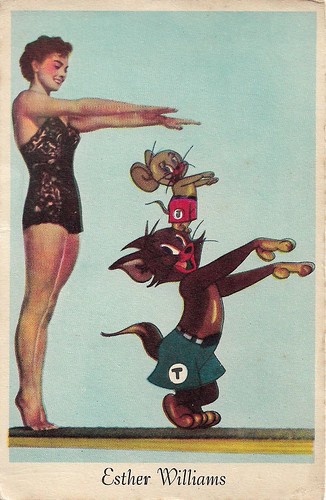
2. Esther Williams and Tom & Jerry in Dangerous When Wet
Country of editor unknown. Collectors card. Photo: M.G.M. Publicity still for Dangerous When Wet (Charles Walters, 1953).
I don’t know if I ever saw the full film, but clips I saw plenty, e.g. in a MGM jubilee compilation film. The combination of animation with live action was already known at the time of the magic lantern, but my own meeting with the genre was with the Alice shorts by Disney, of which many were found at the EYE Film Museum when I was working in their nitrate archive in Overveen in the early 1990s. Of course, one may also think of Who’s Framing Roger Rabbit?
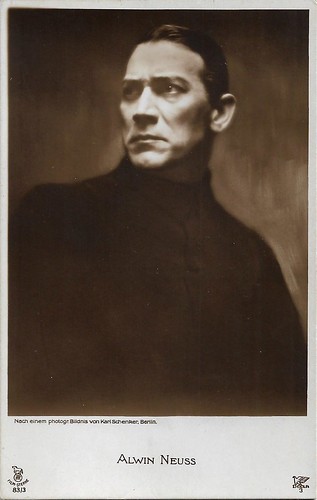
3. Alwin Neuss
German postcard in the Film-Sterne series by Rotophot, no. 83/3. Photo: Karl Schenker / Decla.
Over the years, working on this site and on Flickr we got more and more intrigued by certain photographers recurring at the postcards. One was Karl Schenker, who was a master in studio photography in the 1910s and 1920s. His style is clearly related to Pictorialism in photography. This card well shows his interest in dramatic lighting and clair-obscur, what in film terms was sometimes called 'Rembrandt lighting'. A few years ago an exhibition on Schenker was held in Germany, of which we acquired the catalogue.

4. Mariya Germanova
German postcard. Mariya Germanova as Olga in 'Three Sisters', by Anton Chekhov. Guest performances by the Moscow Art Theatre (in Germany, 1920s).
Mariya or Maria Germanova must have clearly been one of the monstres sacrés of the Russian stage, who also exported her dramatic acting outside of Russia with a troupe of the Moscow Art Theatre. After having played in a handful of films in early Russian cinema, including her debut Anna Karenina (Vladimir Gardin, 1914), she also played in two German films for which the cast was Russian-only: Raskolnikow (Robert Wiene, 1923) and Die Macht der Finsternis (Conrad Wiene, 1924). I obtained a large series of French cards on the actors of the Moscow Art Theatre performing abroad, so these will appear soon on Flickr as well.

5. Marbres vivants
French postcard by Raphael Tuck & Fils Editeurs, Paris, Series 349.
Living statues or 'poses plastiques' were popular stage acts around the 1900s, either imitating (then) famous statues such as those by classic artists such as Michelangelo Buonarotti and Antonio Canova but also now forgotten 19th-century sculptors, or creating a statue-like atmosphere by painting bodies white (marble-like) or green (imitating bronze). Light effects were very important during the shows. While nudity was initially only suggested by women wearing flesh-coloured 'leotards', later on, nudity was shown - provided the models would not move (and thus suggest statues, or in general: art). On this postcard, the women are wrapped in enormous cloths, similar to the popular depiction of artist models in silent film, but also referring to the draperies of Greek and Roman art. ‘Poses plastiques’ were popular in silent cinema too, while future Italian diva Hesperia started her career with ‘living statues’ on stage.

6. Alexander Kerst in Ciske – ein Kind braucht Liebe (1955)
German postcard. Omega Film. Autographed postcard of Alexander Kerst in Ciske - Ein Kind Braucht Liebe (Wolfgang Staudte, 1955), based on the novel by Dutch author Piet Bakker.
This was the German version of the parallel made Dutch film Ciske, de rat (Wolfgang Staudte, 1955), situated and shot in the city of Amsterdam (with interiors shot at the Amsterdam Cinetone film studio). Kerst played the sailor Freymuth, Ciske's father. Part of the Dutch cast played in the German version as well, including Kees Brusse as Ciske's teacher Bruis, and young Dick van der Velde as Ciske himself. Rob de Vries played Kerst’s role of Ciske’s father. While the Dutch version became the third best viewed Dutch film in the Netherlands ever and won a Silver Lion in Venice, the German version was not a huge success in Germany and remained one of the most unknown films of Staudte.
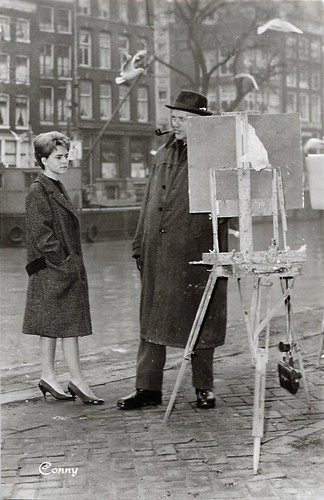
7. Conny Froboess in Amsterdam
Dutch postcard by Ed. Int. Filmpers, Amsterdam.
This card well ties in with a major project I am co-curating, a large retrospective on Dutch-German film exchange since the 1890s, to be held at the 2020 Cinefest in Hamburg. We will also co-organise an accompanying conference, a catalogue, and afterward, a book. For this, we will look e.g. at the popularity of German cinema in the Netherlands, confirmed by the visits of many German stars, before and after the war. Cornelia ‘Conny’ Froboess (1943), though a singer in the first place, was also a popular film actress in German Schlager-Filme. She visited the Netherlands a few times, probably first in May 1959 when she visited Amsterdam to promote her new film Teenager-Melodie/Wenn die Conny mit dem Peter (Fritz Umgelter, 1958). She returned in February 1960 for a performance at the Scheveningen Kurhaus during a dance contest, and in September 1962 for the Grand Gala du Disque. On Dutch Conny-mania, see Mustafa Özen's article in the Dutch magazine TMG.

1. Napoléon vu par Abel Gance
French postcard, no. 469. Albert Dieudonné in Napoléon, vu par Abel Gance (1927).
Ivo: I already had a faded black-and-white postcard with this photo, but this sepia version is much more attractive and has additional text too. I once saw a marathon version of this masterful, sophisticated, poetic, but also very lengthy film at a theatre in Udine, Italy, as a special programme included at the Giornate del Cinema Muto in Pordenone, Italy. We were transported by steam train. Also, we had a buffet in-between, devoured by mostly the Italians, so e.g. too modest Japanese guests must have suffered hunger that night.

2. Esther Williams and Tom & Jerry in Dangerous When Wet
Country of editor unknown. Collectors card. Photo: M.G.M. Publicity still for Dangerous When Wet (Charles Walters, 1953).
I don’t know if I ever saw the full film, but clips I saw plenty, e.g. in a MGM jubilee compilation film. The combination of animation with live action was already known at the time of the magic lantern, but my own meeting with the genre was with the Alice shorts by Disney, of which many were found at the EYE Film Museum when I was working in their nitrate archive in Overveen in the early 1990s. Of course, one may also think of Who’s Framing Roger Rabbit?

3. Alwin Neuss
German postcard in the Film-Sterne series by Rotophot, no. 83/3. Photo: Karl Schenker / Decla.
Over the years, working on this site and on Flickr we got more and more intrigued by certain photographers recurring at the postcards. One was Karl Schenker, who was a master in studio photography in the 1910s and 1920s. His style is clearly related to Pictorialism in photography. This card well shows his interest in dramatic lighting and clair-obscur, what in film terms was sometimes called 'Rembrandt lighting'. A few years ago an exhibition on Schenker was held in Germany, of which we acquired the catalogue.

4. Mariya Germanova
German postcard. Mariya Germanova as Olga in 'Three Sisters', by Anton Chekhov. Guest performances by the Moscow Art Theatre (in Germany, 1920s).
Mariya or Maria Germanova must have clearly been one of the monstres sacrés of the Russian stage, who also exported her dramatic acting outside of Russia with a troupe of the Moscow Art Theatre. After having played in a handful of films in early Russian cinema, including her debut Anna Karenina (Vladimir Gardin, 1914), she also played in two German films for which the cast was Russian-only: Raskolnikow (Robert Wiene, 1923) and Die Macht der Finsternis (Conrad Wiene, 1924). I obtained a large series of French cards on the actors of the Moscow Art Theatre performing abroad, so these will appear soon on Flickr as well.

5. Marbres vivants
French postcard by Raphael Tuck & Fils Editeurs, Paris, Series 349.
Living statues or 'poses plastiques' were popular stage acts around the 1900s, either imitating (then) famous statues such as those by classic artists such as Michelangelo Buonarotti and Antonio Canova but also now forgotten 19th-century sculptors, or creating a statue-like atmosphere by painting bodies white (marble-like) or green (imitating bronze). Light effects were very important during the shows. While nudity was initially only suggested by women wearing flesh-coloured 'leotards', later on, nudity was shown - provided the models would not move (and thus suggest statues, or in general: art). On this postcard, the women are wrapped in enormous cloths, similar to the popular depiction of artist models in silent film, but also referring to the draperies of Greek and Roman art. ‘Poses plastiques’ were popular in silent cinema too, while future Italian diva Hesperia started her career with ‘living statues’ on stage.

6. Alexander Kerst in Ciske – ein Kind braucht Liebe (1955)
German postcard. Omega Film. Autographed postcard of Alexander Kerst in Ciske - Ein Kind Braucht Liebe (Wolfgang Staudte, 1955), based on the novel by Dutch author Piet Bakker.
This was the German version of the parallel made Dutch film Ciske, de rat (Wolfgang Staudte, 1955), situated and shot in the city of Amsterdam (with interiors shot at the Amsterdam Cinetone film studio). Kerst played the sailor Freymuth, Ciske's father. Part of the Dutch cast played in the German version as well, including Kees Brusse as Ciske's teacher Bruis, and young Dick van der Velde as Ciske himself. Rob de Vries played Kerst’s role of Ciske’s father. While the Dutch version became the third best viewed Dutch film in the Netherlands ever and won a Silver Lion in Venice, the German version was not a huge success in Germany and remained one of the most unknown films of Staudte.

7. Conny Froboess in Amsterdam
Dutch postcard by Ed. Int. Filmpers, Amsterdam.
This card well ties in with a major project I am co-curating, a large retrospective on Dutch-German film exchange since the 1890s, to be held at the 2020 Cinefest in Hamburg. We will also co-organise an accompanying conference, a catalogue, and afterward, a book. For this, we will look e.g. at the popularity of German cinema in the Netherlands, confirmed by the visits of many German stars, before and after the war. Cornelia ‘Conny’ Froboess (1943), though a singer in the first place, was also a popular film actress in German Schlager-Filme. She visited the Netherlands a few times, probably first in May 1959 when she visited Amsterdam to promote her new film Teenager-Melodie/Wenn die Conny mit dem Peter (Fritz Umgelter, 1958). She returned in February 1960 for a performance at the Scheveningen Kurhaus during a dance contest, and in September 1962 for the Grand Gala du Disque. On Dutch Conny-mania, see Mustafa Özen's article in the Dutch magazine TMG.

8. Viggo Larsen in Der Sohn des Hannibal (1918)
German postcard in the Film-Sterne series by Rotophot, no. 542/3. Photo: Messter-Film, Berlin. Viggo Larsen in Der Sohn des Hannibal (1918), directed by himself. The woman with the gun is Käthe Haack.
Plot: The racing team owner Count Ferdinand Muntaniz buys a racehorse, a descendant of the stallion Hannibal, and calls it "Imperator". Immediately he bets with Count Szivarwany that the horse will win the first derby. Due to race shifts and game losses, Count Ferdinand is forced to resell Imperator but he has recovered his losses through the bet. Viggo Larsen (1880-1957) was a Danish actor, director, scriptwriter and producer. He was one of the pioneers in film history. With Wanda Treumann he directed and produced many German films of the 1910s. I have no clue why on this card Haack carries a gun and why Larsen is so happy reading the letter, but guns and letters were most important props in silent cinema, as writer Colette has also confirmed.
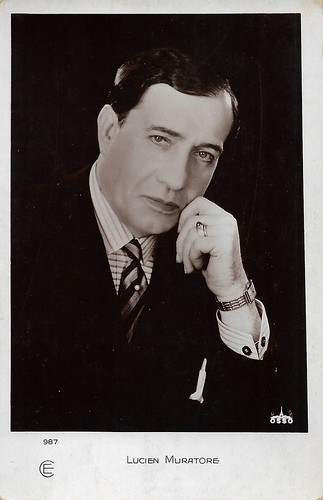
9. Lucien Muratore.
French postcard by Editions Cinémagazine, Paris, no. 987. Photo: Les Films Osso.
Lucien Muratore (1876–1954) was a French actor and operatic tenor, who acted in the 1910s in several American and Italian silent films opposite his then-wife Lina Cavalieri. In the 1930s he also acted in four French sound films. This postcard refers to his first sound film, Le chanteur inconnu/The Unknown Singer (Viktor Tourjansky 1931), made for Les Films Osso. This card shows Muratore was a man of 50 by then but still looking good, even if a bit stiff. Mark the elegant wristwatch, the ring and the tie-pin: quite fancy.

10. Jane Faber
French postcard, editor unknown. Photo: Reutlinger.
Jane Faber (1880-1968) was a Belgian actress, who was active in French cinema of the 1910s and is best known for her role as Princess Sonia Danidoff in the Fantomas crime serial (1913-1914) by Louis Feuillade, made for Gaumont. Before her start in film, Jane Faber already must have been a popular theatre actress, whose last name was enough to promote her. Watch the ‘droit-devant’-like dress with the long trail, the lace sleeves, the hourglass waist, and the ‘Gainsborough’ hat.
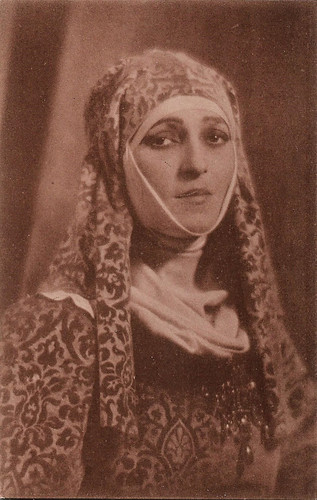
11. Marie Ventura
French postcard by Editions Sid. Photo: G.L. Manuel Frères, Paris.
Marie or Maria Ventura (1888-1954) was a Romanian-French actress and theatre director. She became well known in the silent cinema with her role in the popular serial Les misérables (1912). From 1919 to 1941, she worked at the Comédie-Française. In 1938, she directed 'Iphigénie' by Racine, becoming the first woman to direct a play at the Comédie-Française. At the fair, I obtained various cards by Editions Sid, so these will be uploaded soon.

12. Józef Wegrzyn
Polish (?) postcard by Ed. "Victoria" PW, no. 67.
Polish actor Józef Wegrzyn (1884–1952) is considered one of the most important figures of pre-war Polish theatre and cinema. I was happy to find this card, because the Polish cinema before the war was a blind spot to us until recently. Over the last months, we already found a few cards on actresses of the Polish silent screen on the net. One of them, Jadwiga Smosarska, proved to have often been paired with Józef Wegrzyn in silent films, though not always as lovers. See also our former post on the Polish pre-war cinema.

13. Paul Vincenti
German postcard by Ross Verlag, Berlin, no. 5456/1. Photo: Atelier Amster, Berlin.
Paul Vincenti is a mystery actor. All we know is he acted in two silent Hollywood films in 1927, one by Alexander Korda and one by George Fitzmaurice. At the advent of the talkies, he moved (back?) to Europe, where he acted in four German films between 1929 and 1934. The first was the Czech-German coproduction Kennst du das kleine Haus am Michigansee? (Max W. Kimmich, Viktor Brumlík, 1929). Then, Vincenti had the male lead opposite Gretl Theimer in Die Csikosbaroneß (Jakob & Luise Fleck, 1930). So was he Hungarian? He might just as well have been German, Czech, American, or even Maltese - the name Vincenti is quite common there.
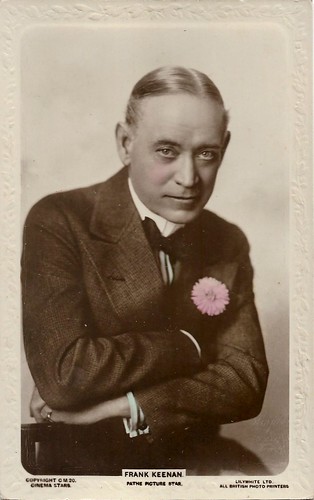
14. Frank Keenan
British postcard by Lilywhite Ltd., no. 20. Photo: Pathé.
Frank Keenan (1858–1929) was an American stage actor and director and was among the first stage actors to star in American cinema. From 1909 to 1926 he appeared in some 70 films, and also directed four films himself. Keenan peaked around 1918-1919 as the star in several films released by Pathé Exchange, e.g. the crime drama The Bells (Ernest C. Warde, 1918) and the Western The Midnight Stage (Ernest C. Warde, 1919). Over the last months, we majorly expanded our collection territory by delving into European postcards for American cinema. This inspired to expand my collection of silent cinema postcards for American stars, including those of pre-Hollywood 1910s stars of Eastcoast companies such as Pathé, or the Chicago-based company Vitagraph. A separate post on the American Pathé company will appear soon.

15. Johnny Sheffield ‘Boy/ Bomba’
Belgian collectors card, Series KF 12. Photo: Monogram.
Johnny Sheffield (1931-2010), well-known as Boy in the Tarzan movies, went on to star in his own jungle films, starting with Bomba, the Jungle Boy (1949). This card mentions this film, so it is probably from around that year.

16. Ricardo Montalban
French postcard by Editions P.I., Paris, no. 500. Photo: Metro-Goldwyn-Mayer, 1953.
Handsome Mexican actor Ricardo Montalban (1920-2009) was the epitome of elegance, charm and grace on film, stage and television. In the late 1940s and early 1950s, he reinvigorated the Latin Lover style in Hollywood without achieving top screen stardom. He fought to upscale the Latin image in Hollywood and this may have cost him a number of roles along the way, but he gained respect and a solid reputation and provided wider-range opportunities for Spanish-speaking actors. Montalban is probably best remembered for his starring role as the mysterious Mr. Roarke on the TV series Fantasy Island (1977–1984), with Hervé Villechaize as his partner Tatto, and as Grandfather Valentin in the Spy Kids franchise.
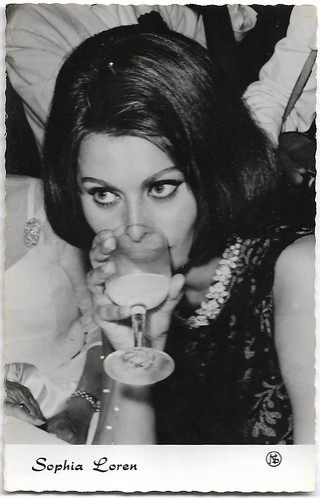
17. Sophia Loren
Dutch postcard by NS, no. 18. On the back, the numbers 621024 might be the date of printing, so 24 October 1962. She had the same hair style at the time she won the Oscar. (Thanks, Philip Mayer @ Flickr).
Sophia Loren (1934) rose to fame in post-war Italy as a voluptuous sex goddess. Soon after she became one of the most successful stars of the 20th Century, who won an Oscar for her mother role in La ciociara (Vittoria De Sica, 1960). I love Sophia, that is: the Sophia of her Italian highlights Peccato che sia una canaglia, Boccaccio ’70, La ciociara, Matrimonio all'italiana, and in particular Una giornata particolare. Though I am less fond of her foreign films, on festivals, during research, and on YouTube, I started to discover La fortuna di essere donna, I sequestrati di Altona, The Fall of the Roman Empire, and some of her song or dance scenes, such as the mambo in Pane, amore e…, and her version of 'Tu Vuò Fà L'Americano' in It happened in Naples. Cin!
No comments:
Post a Comment